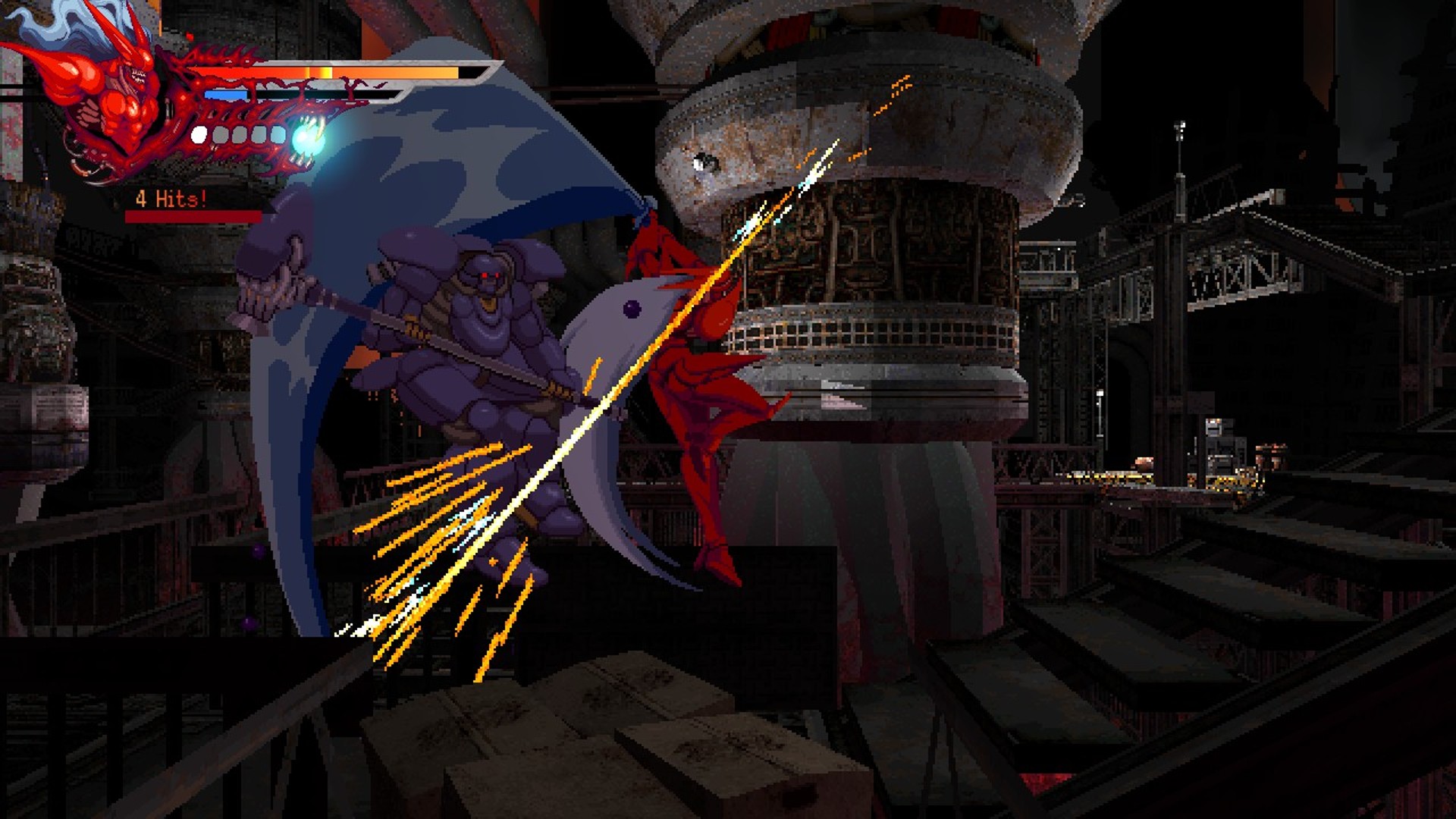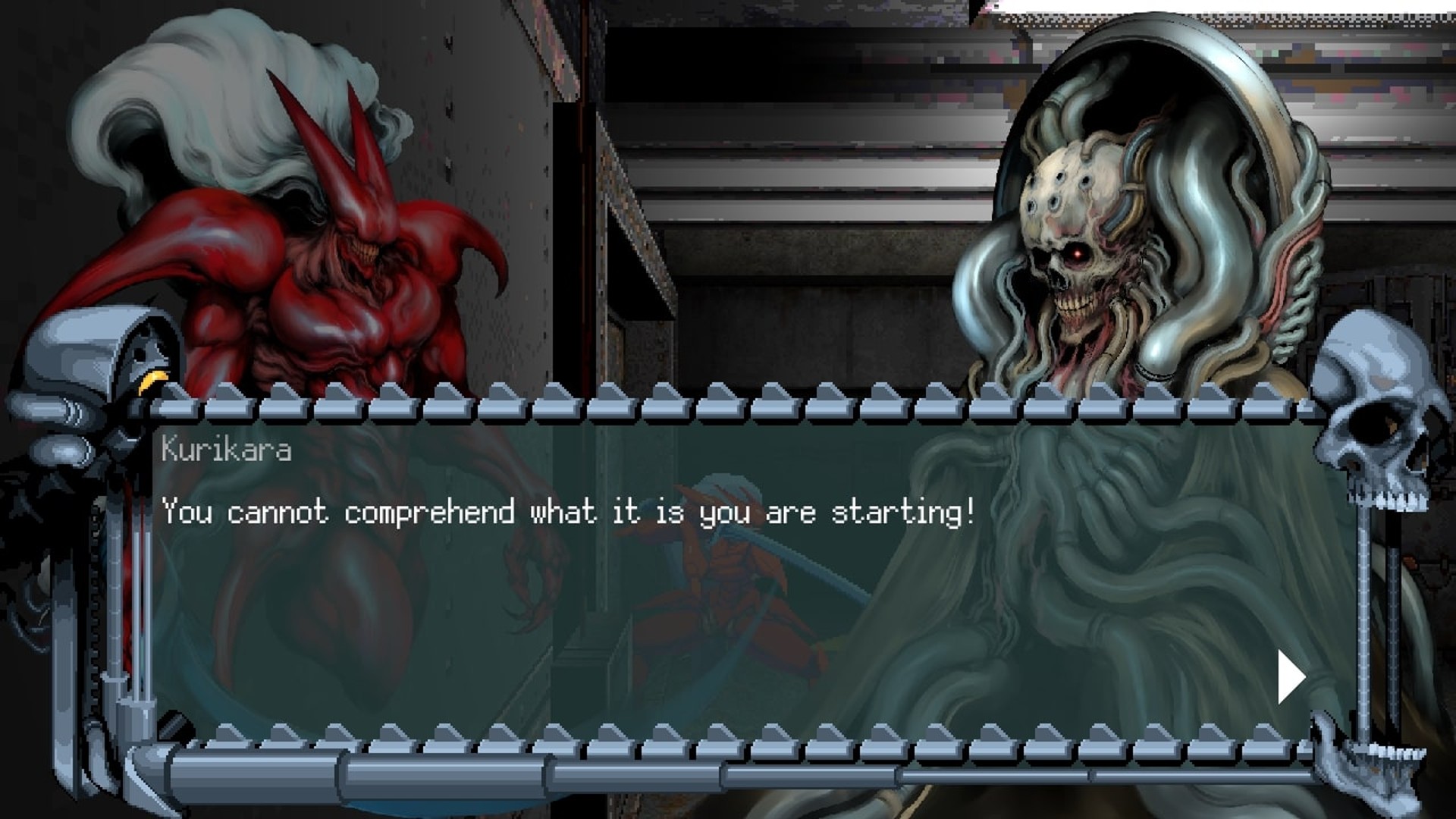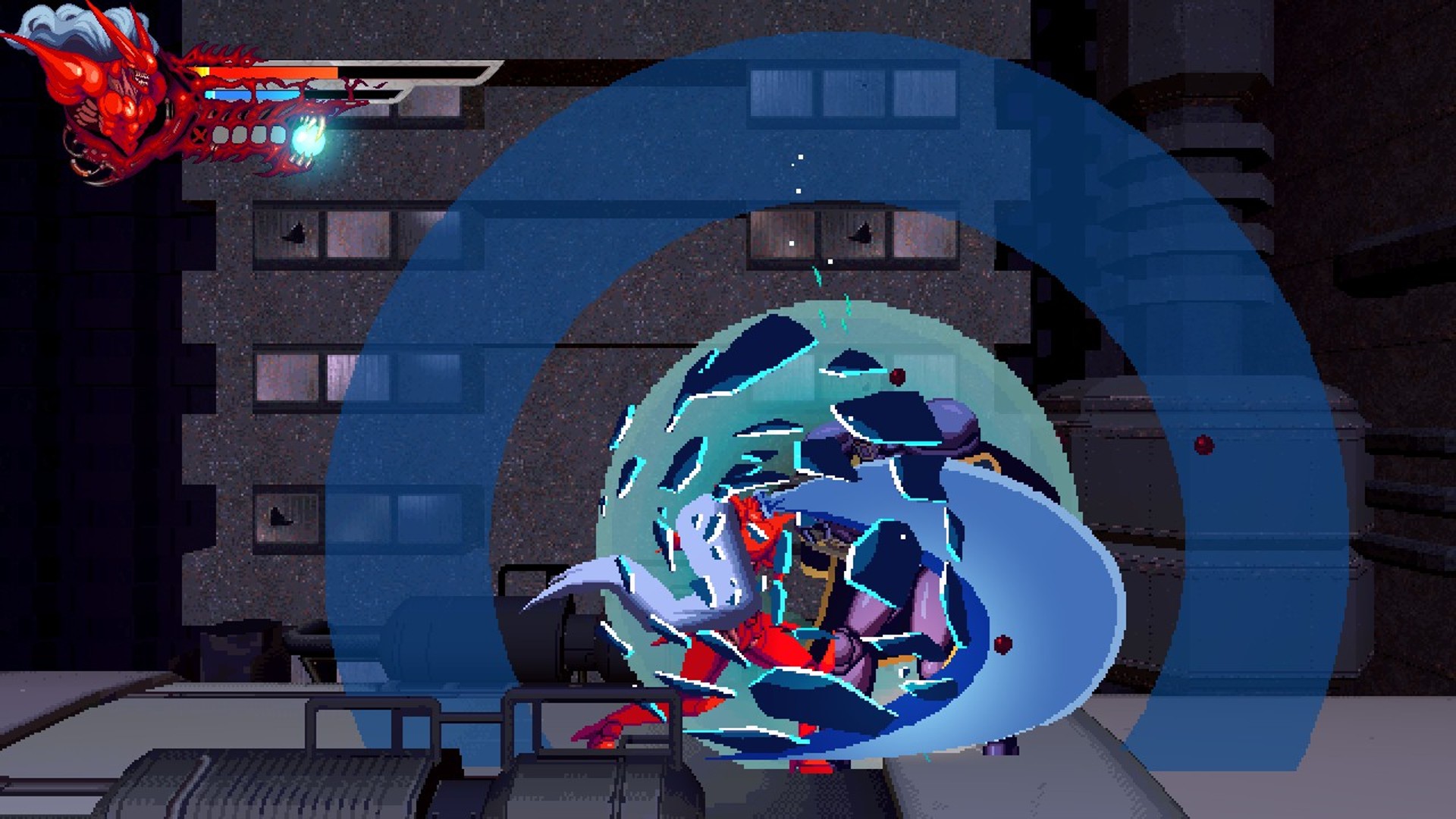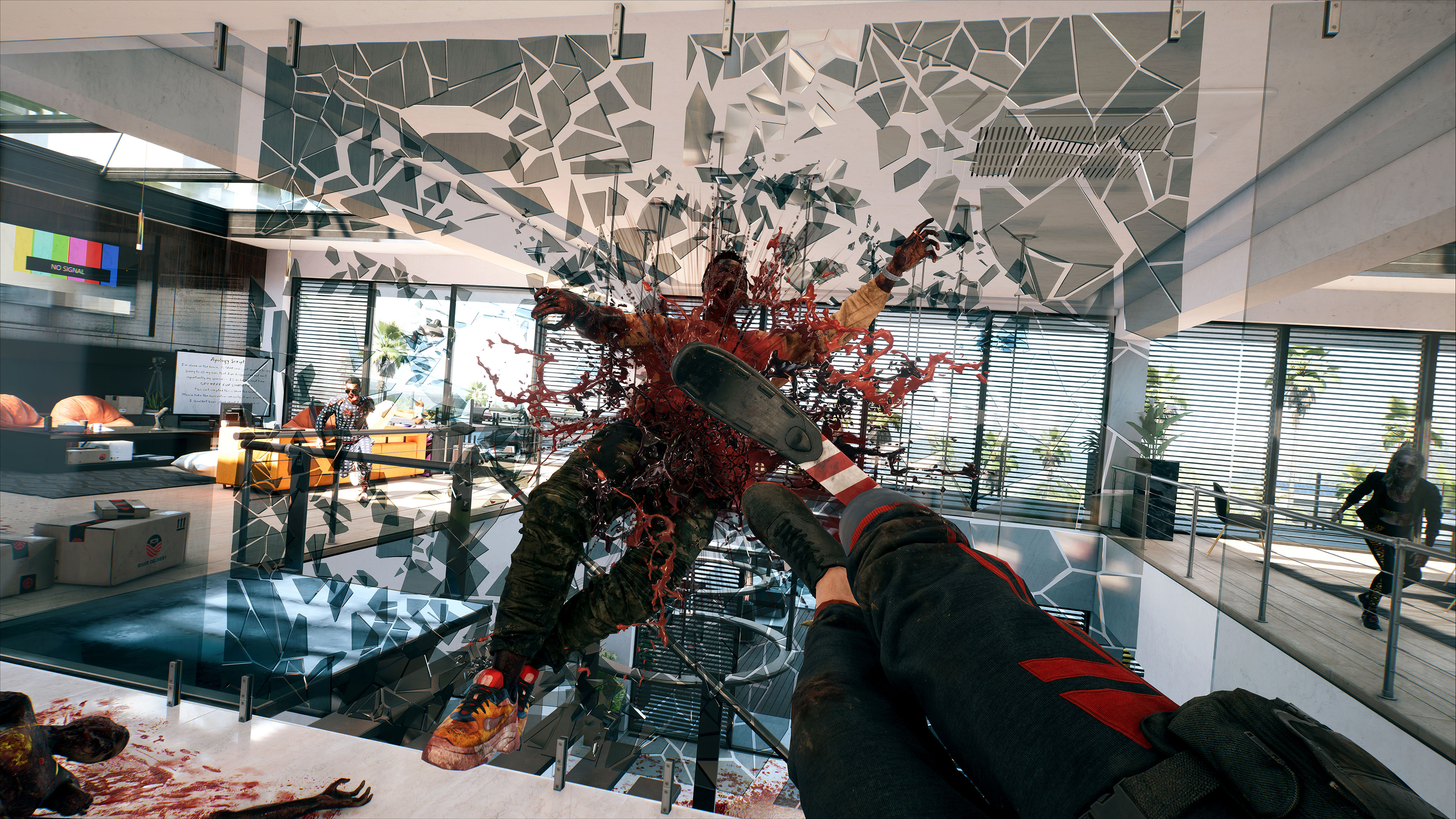Punching an enemy so hard that its ribs pop out, and other ways that Slave Zero X is "bringing a little bit of the horror back into character action games"
Interview | Francine Bridge and Alex Lotz talk indie horror, working with sprites, and the unexpected nature of Slave Zero X

Slave Zero X is not a horror game, but it was pretty much made like one. Spine-chilling sensibilities fortify the game's skeleton much like adamantium does Wolverine's, punctuating its side-scrolling beat-'em-up combat with the DNA of something altogether horrific. Rib cages are torn out of enemies effortlessly, flying across the screen with every punch landed. There's something called a bug bomb that is every bit as gross as it sounds. But with developer Poppyworks dubbing it the "spiritual prequel" to 1999's Slave Zero, it's clear that the original game didn't lean as heavily into this strong visual language of body horror, violence, and other facets familiar to all fans of the best horror games. That's something art director Francine Bridge sought to correct.
"I came to horror as a genre, first and foremost, because it's where you see these very elaborately constructed monsters and practical effects and the design philosophy behind that," Bridge says of how horror inspires their work as an artist. "Then after the fact, I came to understand and appreciate the art in and of itself. The art of how you scare someone, the art of how you create an unsettling atmosphere and maintain that without breaching it – or that if you do breach that unsettling atmosphere, how do you still make it entertaining in its own right?"
Bruiser

At first blush, Slave Zero X is a 2.5D fighting game that sees our protagonist, Shou, defeat wave upon wave of mutant enemies by way of X: a turbo-charged biomechanical weapon he's stolen to do the dirty work. The action-brawler takes place four years prior to the events of Slave Zero, but as Bridge explains above, it's not meant to retcon. In fact, when it comes to the game's design philosophy, both Bridge and Ziggurat Interactive managing producer Alex Lotz are quick to emphasize how Slave Zero X is not about rebooting or creating a sequel of the original, but reimagining its essence within new stylistic parameters.
For Bridge, it all started with "capturing the atmosphere" as the 1999 developer intended. "We kept just enough of the DNA of the original, assuring that there's actually some direct crossover," says Bridge, with Lotz reaffirming that some of the locations in Slave Zero X are inspired, drawn, or expanded from Slave Zero's own concept art. "But aside from making sure that the broadest strokes are made consistent, like for instance, [antagonist] Sovereign Khan being in both games, we weren't being slavishly accurate to the original – if you'll pardon the pun, I guess."
According to Lotz, the idea of leaning more heavily on the game's existing horror threads just feels like the next logical step in the series' evolution. "[In Slave Zero], there was very much a sense that the executives, or people who were in charge of the game, were kind of like, 'maybe you guys should tone it down a little bit'. But that stuff is still in the DNA of the original," says Lotz.
Ultimately it was all about context. "In the late 90s, they weren't ready for a mainstream product to have some of those horror elements, or some of those aesthetic elements, or some of the animated elements." Now, however, we certainly are.
Getting away with murder

We weren't being slavishly accurate to the original – if you'll pardon the pun.
Francine Bridge
It might be hard to communicate body horror and gore through lo-fi pixel sprites, but Slave Zero X finds a way to bring home the ick factor. A key component in that? Gratuitous and frankly silly levels of gore, not unlike how Dead Island 2 taps that absurdist 80s horror vein. See earlier: rib cages popping out of enemies as you punch them
Sign up to the GamesRadar+ Newsletter
Weekly digests, tales from the communities you love, and more
"The idea of punching a person so hard that they come apart is innately horrifying. But then the idea of an entire rib cage popping out of someone's body intact, and there being multiples of that ribcage as you keep punching them…that takes it back into absurdity," reasons Bridge. "The base concept is still incredibly unnerving at face value. I think there's this very fine line between something that is genuinely horrifying and something that is just horror in a fun, pulpy, spectacle sense."
This same sensibility applies to the Game Over animation, wherein Shou/X gets flayed alive before exploding upon death. "It's kind of supposed to call back to things like Metroid Prime," laughs Bridge. "Traditionally, when Samus takes a fatal amount of damage, she flies into the middle of a screen and then the suit explodes. And in that scene, it's the death of Samus, but it's also kind of the death of the suit, which is this character in its own sense. It represents this ultimate moment of true death; the suit is dead, Samus is dead, it's a two-part death. We wanted to do a much more gory version of it."
Much like Samus' suit, Shou in many ways "wears" X, using it as a tool or avatar through which to combat his foes. That brings with it whole new questions of player agency, power imbalances, and how those factor into creating a horror experience in a video game. "The more agency the player has traditionally, the lower the sort of horror quotient is," says Bridge. In short: "The more control you give them, the less unsettling it can be.
"In Slave Zero X that's doubly important because you're talking about a game where the player character is actually deliberately overpowered. The first few levels are designed almost as a power fantasy. You are the horrifying thing that emerges from the depths of the city and begins a sort of slasher [tirade], moving your way up through the city, and you have other characters expressing fear about you."
Hidden depths

The more agency the player has traditionally, the lower the sort of horror quotient is.
Francine Bridge
Atmospheric and delightfully macabre as Slave Zero X may be, Poppyworks is still working predominantly with sprites, 2.5D pixel backdrops, and hand-drawn art. Spritework is bound to bring some design specifications along with it, and though Slave Zero X naturally doesn't have the sharp ray-traced detail of the likes of Resident Evil 2 Remake, that didn't make the visual processes a walk in the park to execute by any measure.
"There's a certain number of people that when they hear words like 'indie game', or they hear the word 'lo-fi', or 'retro style', they might think 'oh, well, that's lower fidelity. Therefore, maybe it takes less work to create'," says Lotz. But building a horror-soaked atmosphere is about more than "high polycount models and all these crazy shaders."
"I saw how much work went into those sprites. There's a lot of craft that goes into it. I think the art team was a lot bigger than any other kind of department on the project, and that was just from the raw amount of assets that we needed to fill out the world. And, you know, beat-'em-up games tend to be on the shorter side. But this is a game that's just set piece after set piece."
At its heart, Slave Zero X is a character action game with a thick coat of viscera for good measure. It's the kind of arcade throwback experience that will click with something primally nostalgic in all of us, all while "bringing a little bit of the horror back into character action games", according to Bridge.
"In a horror game, and in a more hardcore action game, like, the point is the challenge," Lotz finalizes. "The point is the friction, the point is feeling rewarded, or feeling like you grew and you overcame. It feels like growth."
For something that treads closer to the tracks of terror, check out all the upcoming horror games for 2024 and beyond.

Jasmine is a staff writer at GamesRadar+. Raised in Hong Kong and having graduated with an English Literature degree from Queen Mary, University of London in 2017, her passion for entertainment writing has taken her from reviewing underground concerts to blogging about the intersection between horror movies and browser games. Having made the career jump from TV broadcast operations to video games journalism during the pandemic, she cut her teeth as a freelance writer with TheGamer, Gamezo, and Tech Radar Gaming before accepting a full-time role here at GamesRadar. Whether Jasmine is researching the latest in gaming litigation for a news piece, writing how-to guides for The Sims 4, or extolling the necessity of a Resident Evil: CODE Veronica remake, you'll probably find her listening to metalcore at the same time.



